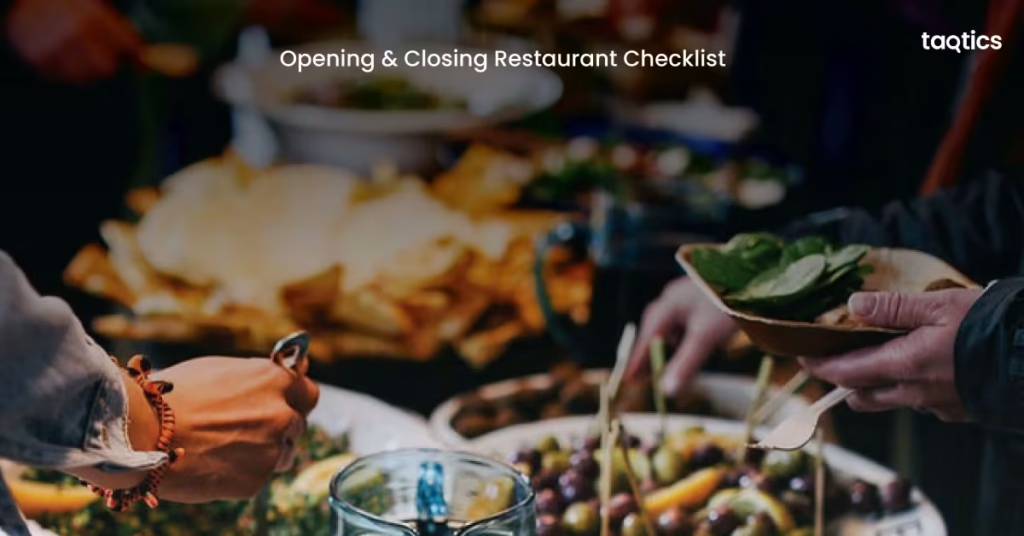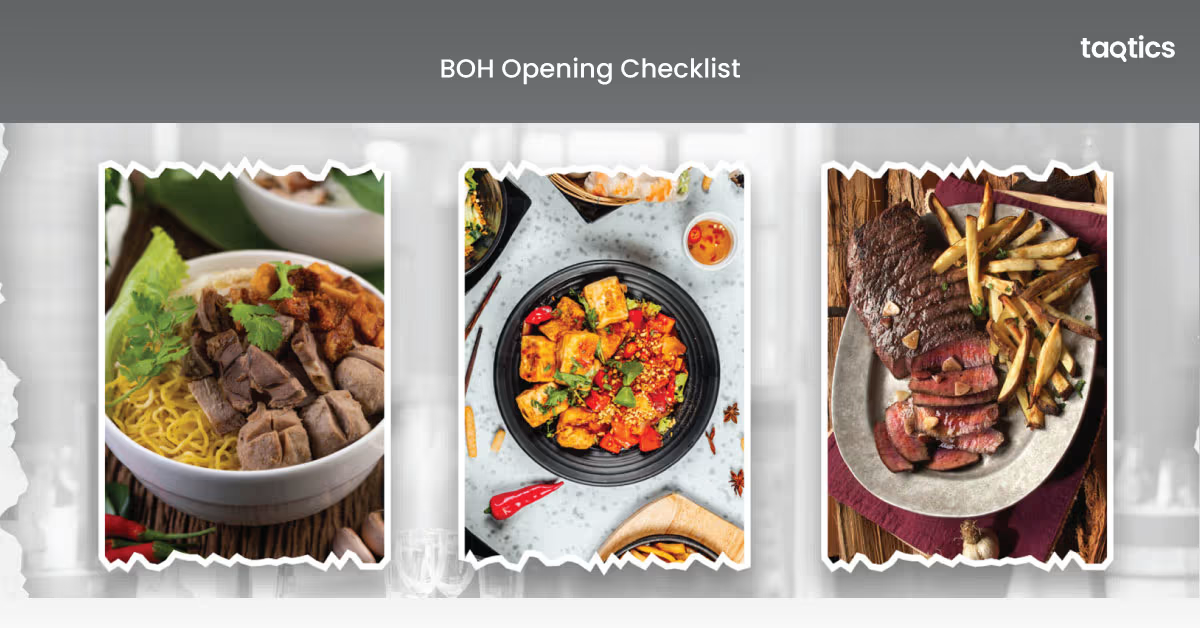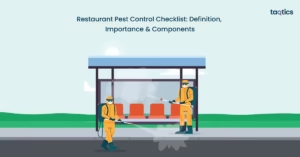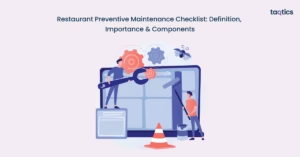Opening & Closing Restaurant Checklist

Opening & Closing Restaurant Checklist is a critical operational tool that ensures smooth, efficient, and compliant restaurant management. Opening & Closing Restaurant Checklist tasks help reduce errors, maintain food safety, and improve team accountability, key to sustaining daily performance. According to a report by the National Restaurant Association, consistent daily routines can boost operational efficiency by up to 30% and reduce food waste by as much as 20%.
These checklists cover vital steps such as equipment startup, inventory checks, food prep, sanitation, and cash reconciliation—helping teams prevent oversights and maintain health code compliance. In fact, restaurants that follow structured opening and closing routines are 2.5 times more likely to pass health inspections on the first attempt. They also create a culture of discipline and readiness, where employees are clear on expectations and managers gain better visibility into operations.
By standardizing these workflows, restaurants can also improve labor productivity and guest satisfaction. A Cornell Hospitality study found that venues with well-documented opening and closing procedures saw a 17% decrease in employee onboarding time and a 12% increase in customer satisfaction scores. Whether you’re a quick-serve franchise or a fine-dining establishment, having a reliable checklist helps you open and close with confidence.
What is a Opening & Closing Restaurant Checklist
Opening & Closing Restaurant Checklist refers to a set of standardized procedures that restaurant staff follow at the start and end of each shift. Opening & Closing Restaurant Checklist tasks are essential for ensuring that daily operations begin smoothly and end cleanly, safely, and efficiently. These checklists reduce confusion, promote accountability, and contribute to higher guest satisfaction. According to a study by Restaurant365, restaurants that consistently use structured checklists see a 25% reduction in service delays and a 15% improvement in team productivity.
An Opening Checklist typically includes tasks like turning on equipment, checking inventory levels, prepping ingredients, sanitizing workstations, and conducting safety inspections. This ensures that the restaurant is clean, stocked, and ready for service before the first guest walks in. Meanwhile, a Closing Checklist focuses on tasks such as shutting down kitchen equipment, cleaning surfaces, locking up inventory, balancing cash registers, and securing the premises. These steps help reduce food waste, maintain cleanliness, and prepare the space for the next day, which are critical factors that influence operational consistency and food safety compliance.
Checklists also play a significant role in staff training and accountability. According to the National Restaurant Association, restaurants that use clearly defined opening and closing routines reduce onboarding time by up to 20% and report 30% fewer operational errors. Overall, these checklists are more than just routines. They are a foundation for running a safe, compliant, and well-managed restaurant.
Why You Need Opening & Closing Restaurant Checklist
You need opening and closing restaurant checklists to run a smooth, efficient, and compliant operation. They eliminate guesswork, reduce staff confusion, and ensure that critical tasks are never overlooked.
- Reduce operational errors and staff confusion: Clear task lists ensure everyone knows their responsibilities, minimizing missteps during shift changes.
- Meet health code compliance: Checklists help enforce consistent food safety, sanitation, and storage practices, which are key for passing health inspections.
- Improve staff training and onboarding: New hires can follow step-by-step instructions, reducing training time and increasing their confidence and performance.
- Increase team efficiency and morale: With organized routines, employees feel less overwhelmed, more productive, and better supported.
- Support time-saving and cost control: Routine checks help avoid waste, prevent equipment issues, and save time by streamlining daily operations.
According to Toast POS, restaurants using structured checklists experience 30% fewer missed tasks and a 25% improvement in team communication. Opening and closing checklists are essential tools for driving performance, maintaining standards, and ensuring a seamless start and end to each shift.
What are the Checklist Categories & Roles
The checklist categories and roles in a restaurant are typically divided into front of house (FOH), back of house (BOH), and managerial responsibilities. Breaking down the tasks by role improves clarity, accountability, and teamwork.
FOH Opening Checklist
The FOH Opening Checklist, as part of the overall checklist categories and roles in restaurant operations, focuses on preparing the front-of-house for a smooth and welcoming guest experience. This checklist is critical in setting the tone for the day and ensuring that every customer interaction begins on the right note. According to the Deloitte Restaurant Experience Survey, 70% of customers form their impression of a restaurant within the first five minutes, making FOH readiness a direct contributor to customer satisfaction and loyalty.
Key tasks in the FOH opening checklist include unlocking the doors, adjusting the lighting, and setting up background music to create an inviting atmosphere. Staff are also responsible for ensuring tables are set adequately with clean linens, stocked condiments, and fresh menus. Cleanliness and attention to detail are essential, as they reflect the overall quality of the restaurant.
In addition, the host stand must be prepared with the day’s reservation list, a working phone, and any special announcements or menus. Bathroom cleanliness is also a non-negotiable; restrooms should be checked for hygiene, supplies, and general upkeep before opening. Lastly, FOH staff must verify that all POS (Point of Sale) terminals are functioning correctly to prevent service delays. A report by the National Restaurant Association found that operational preparedness, including FOH efficiency, can increase table turnover by up to 15%, significantly boosting revenue potential. With a thorough FOH opening checklist, restaurants can start each day confident in their ability to provide a seamless and professional guest experience.
BOH Opening Checklist
The BOH Opening Checklist, under the broader checklist categories and roles, is essential for preparing the kitchen and food prep areas before service begins. Back-of-house readiness directly affects food quality, safety, and speed of service. A well-executed BOH opening routine reduces errors, prevents cross-contamination, and ensures a streamlined workflow. According to the FDA, over 50% of foodborne illness outbreaks in restaurants are linked to improper food handling and unclean surfaces, issues that a solid BOH checklist helps prevent.

The checklist typically begins with equipment startup, including turning on ovens, grills, fryers, refrigerators, and ventilation systems. Ensuring equipment is operating at optimal temperature early on allows time for adjustments before peak service. This is followed by food prep, such as mise en place, thawing frozen items as per safety standards, and restocking the line with ingredients, sauces, and garnishes, all tasks that support efficient kitchen execution.
Critical temperature checks must also be performed for refrigeration units, hot-holding equipment, and thawing products to stay within food safety guidelines. Staff should log these readings to ensure compliance with local health regulations. Finally, sanitation of all food-contact surfaces, utensils, and cutting boards ensures a hygienic start to the day. A study by ServSafe found that restaurants with strict sanitation routines reduce food safety violations by 40%. With a structured BOH opening checklist in place, kitchens can begin each shift safe, stocked, and ready for consistent, high-quality service.
Manager’s Opening Checklist
The Manager’s Opening Checklist, a core part of the restaurant’s checklist categories and roles, focuses on financial, staffing, and operational readiness. Managers play a pivotal role in setting the tone for the day by aligning teams, ensuring system functionality, and confirming that the restaurant is prepared to deliver both great service and strong sales performance. According to a report by QSR Magazine, restaurants with active managerial oversight during opening hours experience 20% fewer service disruptions and 18% higher employee punctuality.
One of the first tasks is cash drawer verification, where managers confirm opening balances and ensure each terminal has the correct amount of float. This reduces discrepancies later in the day and supports smooth payment processing. Following this, managers hold a daily briefing with FOH and BOH leads to communicate the day’s goals, special menu items, potential challenges, and customer notes, fostering team alignment and proactiveness.
Managers also need to check staff attendance to ensure the right coverage for expected traffic and make any last-minute shift adjustments if required. Finally, reviewing reservations, special events, and syncing POS data ensures that seating plans, kitchen prep, and system configurations are aligned with the day’s forecast. Effective execution of this checklist not only improves operational flow but also boosts team coordination and guest satisfaction. In fact, restaurants with structured manager check-ins report up to a 25% improvement in staff engagement and service consistency.
FOH Closing Checklist
The FOH Closing Checklist, as part of the overall checklist categories and roles, ensures that the front-of-house is appropriately cleaned, reset, and secured for the next day of service. A well-executed FOH closing routine not only maintains hygiene and organization but also protects the restaurant’s assets and brand reputation. According to a survey by the National Restaurant Association, 86% of diners consider cleanliness a key factor in deciding whether to return to a restaurant, making closing procedures just as crucial as opening ones.
Closing tasks begin with cleaning all guest-facing areas, including wiping down tables, bar tops, and soda or coffee stations. These surfaces must be sanitized to prevent residue buildup and maintain a clean appearance. Staff then flip chairs onto tables and vacuum or mop the floors, removing debris and spills that can attract pests or create slip hazards.
Additional steps include restocking and deep-cleaning restrooms, ensuring soap, toilet paper, and paper towels are replenished, and that surfaces are thoroughly disinfected. A clean, well-stocked restroom reflects the restaurant’s overall standards and impacts guest satisfaction. Finally, FOH staff must lock POS terminals, reconcile and secure cash, ensuring all transactions are complete and accounted for. Poor cash handling during closing can lead to discrepancies or security risks, issues that well-defined procedures help prevent. With a strong FOH closing checklist, teams can end the day confidently, knowing the space is clean, safe, and ready to open again without setbacks.
BOH Closing Checklist
The BOH Closing Checklist, within the broader checklist categories and roles, is essential for maintaining kitchen cleanliness, food safety, and operational efficiency at the end of each day. The back-of-house team is responsible not just for food preparation but also for ensuring that the kitchen is properly shut down and ready for the next shift. A study by ServSafe reveals that restaurants following strict BOH closing procedures report 35% fewer food safety violations and significantly lower maintenance costs due to proper equipment care.
Closing tasks begin with shutting down and thoroughly cleaning all kitchen equipment, from ovens and grills to fryers and mixers. This prevents grease buildup, extends the life of appliances, and reduces the risk of fire or mechanical failure. Staff must then dispose of waste properly and sanitize all sinks and drains, which helps prevent clogs, pest infestations, and foul odors. According to the FDA, improper waste handling is one of the top five risk factors contributing to foodborne illness outbreaks.
Another key task is labeling and storing leftovers according to food safety guidelines, including date marking and proper refrigeration. This ensures freshness and reduces waste while complying with local health codes. Lastly, staff must turn off utilities as needed, such as lights, gas lines, and hood systems, to save energy and reduce fire hazards. A well-executed BOH closing checklist not only secures the kitchen overnight but also supports a smoother, safer start the next day.
Manager’s Closing Checklist
The Manager’s Closing Checklist, as part of the restaurant’s checklist categories and roles, is critical for ensuring operational accuracy, team accountability, and the security of the premises. While the FOH and BOH teams focus on cleaning and shutdown procedures, the manager’s role at closing centers on final oversight, financial reconciliation, and preparing the next shift for success. According to Restaurant365, businesses with structured managerial closing routines see up to 28% fewer cash handling discrepancies and improved shift-to-shift continuity.
One of the most important tasks is to count and record all cash, ensuring register totals match sales reports from the POS system. This includes reconciling credit card receipts, gift card sales, and tips. Discrepancies are flagged and investigated immediately, helping prevent theft or accounting errors. Following financial tasks, managers must check task completion logs to verify that both FOH and BOH teams have completed their closing responsibilities. This maintains accountability and cleanliness standards across departments.
After confirming all operational tasks are complete, the manager must secure the facility by locking all entrances, setting the alarm system, and ensuring all non-essential lights and utilities are turned off. Finally, they log any final notes or issues for the next shift, such as equipment malfunctions, staff updates, or special reservations. This handoff supports continuity and keeps the next day’s team informed. A well-executed manager’s closing checklist not only protects the business overnight but also sets the stage for a more efficient and prepared start to the next day.
These categories help assign the right responsibilities to the right team members, ensuring that no critical task is overlooked and every shift starts and ends on a strong note.
How to Implement & Optimize Checklists
To implement and optimize checklists effectively in your restaurant operations, you need to go beyond simply listing tasks. You must create a system that’s practical, adaptable, and embraced by your team. Well-designed checklists reduce human error, improve consistency, and boost accountability. In fact, a study by Harvard Business Review found that when teams use standardized checklists, task completion accuracy can improve by up to 38%.

Start by customizing checklists based on shift type and role, morning prep, mid-shift turnover, and closing duties, which all require different focus areas. Tailoring lists ensures relevance and avoids overloading staff with unnecessary steps. Next, involve your team in checklist development. Getting input from FOH, BOH, and managerial staff helps ensure the checklists are practical, complete, and more likely to be followed.
Use clear, concise language so tasks are easy to understand and execute quickly, especially during busy hours. Then, review and update checklists regularly to reflect menu changes, seasonal shifts, or operational adjustments. Lastly, incorporate checklists into your onboarding process so that new hires are introduced to expectations early on. This reduces training time and sets a standard from day one. When properly implemented, checklists become a powerful tool not just for task management but for building a culture of consistency, quality, and accountability.
How often should you update checklists?
You should update your checklists regularly to ensure they stay relevant, effective, and aligned with your restaurant’s evolving needs. Monthly or quarterly updates are generally recommended, as they allow you to address recurring issues, incorporate staff feedback, and improve workflow efficiency over time. According to a study by the National Restaurant Association, restaurants that review and revise their checklists at least quarterly report a 22% improvement in task compliance and a 17% drop in operational errors.
Checklists should also be updated immediately after any equipment upgrades, layout changes, or updates to health and safety regulations, to ensure compliance and safety. Outdated procedures can lead to missteps, fines, or even service disruptions. Additionally, seasonal menu changes or shifts in staffing patterns, like increased part-time hires during holidays, should prompt a checklist review to ensure prep tasks, training needs, and timing adjustments are properly addressed.
By treating checklists as living documents, not static tools, you keep your team aligned with current practices and ready to deliver consistent service, even as your operation evolves.
What is the difference Between Digital vs. paper checklists?
The difference between digital and paper checklists lies in how tasks are tracked, updated, and integrated into daily operations. Both formats serve the same purpose—ensuring consistency and accountability, but they offer distinct advantages depending on the restaurant’s size, staff, and technology readiness.
- Digital checklists provide real-time tracking, making it easy for managers to monitor task completion and flag missed steps instantly. They often integrate with POS systems, inventory tools, and scheduling software, which streamlines operations and improves data accuracy. Additionally, digital platforms allow for quick updates across multiple locations, ensuring everyone works with the latest version. A study by Restaurant Technology News found that digital checklists can reduce task errors by up to 25% and improve shift handoffs by 30%.
- Paper checklists, in contrast, are low-tech, inexpensive, and easy to implement. They’re ideal for small teams or restaurants with limited access to devices or Wi-Fi. Staff can quickly check off items with minimal training, but paper lacks visibility and historical tracking and can lead to version control issues.
Many restaurants adopt a hybrid approach, using paper for quick reference in the kitchen or front-of-house and digital systems for logging, analysis, and long-term accountability. This blended model offers both flexibility and the ability to scale checklist systems as the business grows.



